One among Debora Fadul’s earliest childhood reminiscences is touring within the backseat of her household’s sedan as her father negotiated lengthy, windy roads to far-flung and verdant villages in Guatemala’s inside. Within the countryside, her father educated schoolteachers to turn out to be higher educators whereas Fadul absorbed data in regards to the richness of Guatemala’s tradition, the folks, the land and the meals it produces.
These journeys are a giant cause Fadul, now 37, grew to become obsessed at a younger age with the components that grew to become her meals — and so they’re probably why she grew to become a chef.
At her restaurant Diacá, in Guatemala Metropolis, she is on the forefront of a motion to reacquaint Guatemalans with their culinary heritage and reconnect this Central American nation of 17 million customers with its farmers and their produce, a lot of it deeply rooted in its many Indigenous cultures.
Jaime Antillon, left, and Emily Meza within the kitchen at Debora Fadul’s Diaca restaurant in Guatemala Metropolis.
(James Rodriguez / For The Occasions/James Rodriguez/Los Angeles Occasions)
She describes Diacá’s meals as cocina explorativa de raíz, or exploratory delicacies from the basis, with historic and native produce central to lots of the dinner programs on her seasonally targeted tasting menus and a la carte lunch dishes.
Practically all of the components she cooks with are from Guatemala. Many have lengthy been utilized by Indigenous folks.
Her efforts haven’t gone unnoticed. In 2023, she earned her highest rating, No. 76, on the Finest Chef High 100 listing, voted on by restaurant trade professionals and members of the media. She was No. 98 on the listing in 2022, the identical 12 months she was acknowledged on the “50 Subsequent” listing for hospitality pioneers by the group that administers the annual World’s 50 Finest Eating places listing. That group additionally ranked Diacá No. 47 on its 2022 listing of Latin America’s 50 Finest Eating places and No. 52 in 2023.
The accolades have drawn many diners — significantly worldwide vacationers — to Diacá. But whereas Fadul appreciates the numerous foreigners who make the pilgrimage to Guatemala Metropolis, her goal diners are her nation’s folks.
“In Guatemala, the Chapín is a vacationer in his personal nation,” says Fadul, utilizing the slang time period, typically spoken with pleasure, for her fellow residents. “Guatemalans don’t know what there’s or what she or he eats. I would like them to reassess, admire and honor these components … to be pleased with what we’ve got right here.”
Her mission isn’t any small feat.
Guatemalans, Fadul says, have a tendency to position extra worth on meals imported from the US or Europe fairly than their very own nation’s merchandise.

Visitors eat in a meals courtroom with a wide range of totally different eating places on the Central Market in Guatemala Metropolis in 2020. (Gary Coronado / Los Angeles Occasions)
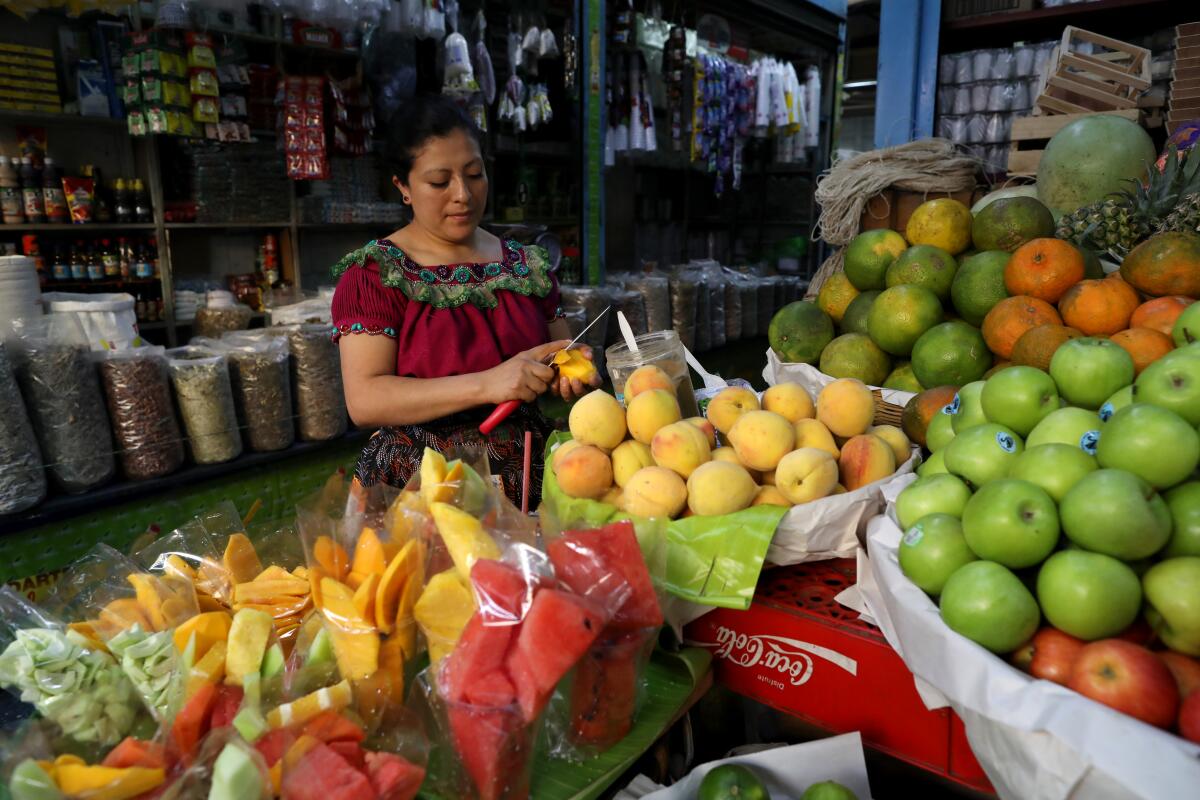
Anabella Juarez prepares reduce mango within the Central Market in Guatemala Metropolis. (Gary Coronado / Los Angeles Occasions)

Calle 6A close to the Central Market within the Historic Middle in Zona 1 in Guatemala Metropolis in 2020.
(Gary Coronado / Los Angeles Occasions)
Though there are an estimated two dozen Indigenous languages spoken in Guatemala and Indigenous folks make up greater than half the inhabitants, they’re nonetheless thought-about an underclass by many within the nation.
Inequality and discrimination towards Indigenous folks runs deep, and that sentiment extends to viewing Indigenous meals and practices as primitive or inferior.
Fadul is making an attempt to vary the narrative and encourage Guatemalans to understand their Mesoamerican roots and to cease wanting overseas for inspiration.
“We have to educate the patron,” she likes to say.
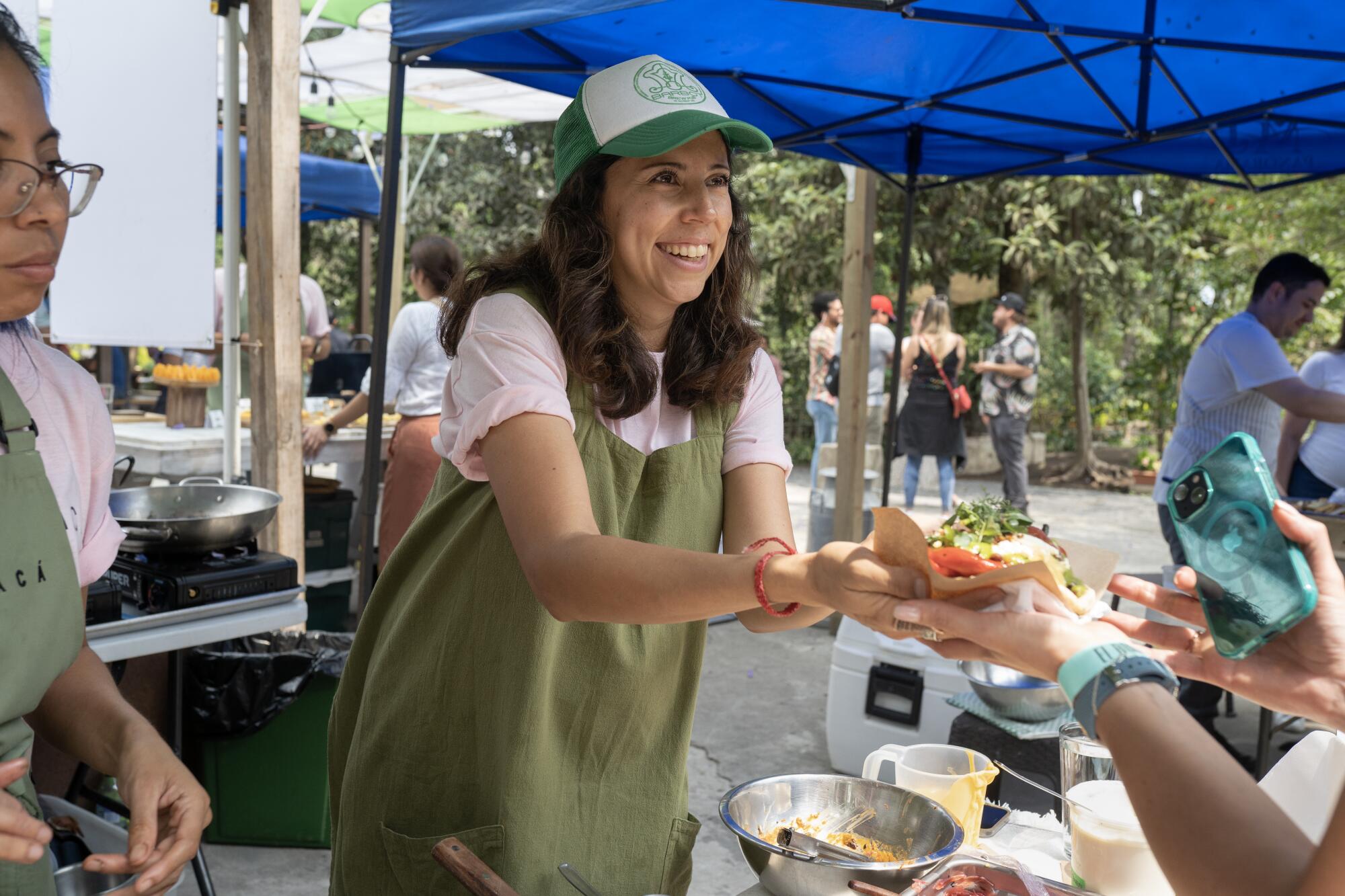
Chef Debora Fadul serves her personal tackle a chile relleno at a meals pageant in Antigua.
(James Rodriguez / For The Occasions/James Rodriguez/Los Angeles Occasions)
Within the fields
On a breezy spring morning Fadul and Christian Paz, her husband and accomplice at Diacá, meet with Juan Manuel Perez, a 35-year-old grower on his land at Tikonel Farms close to Antigua, the nation’s former capital.
Fadul, petite and energetic, makes it some extent to personally go to every of her producers or be sure that somebody on her crew does. She feels it’s vital for the cook dinner to have a relationship with not solely the produce but in addition the land and the individuals who have a tendency it.
“There’s a disconnect,” she says, “between the customers and the producers.”
At Tikonel Farms it’s instantly clear as Fadul and Paz stroll the land with Perez that typical agriculture methods should not practiced right here. Not one neatly manicured furrow of naked soil is in sight.
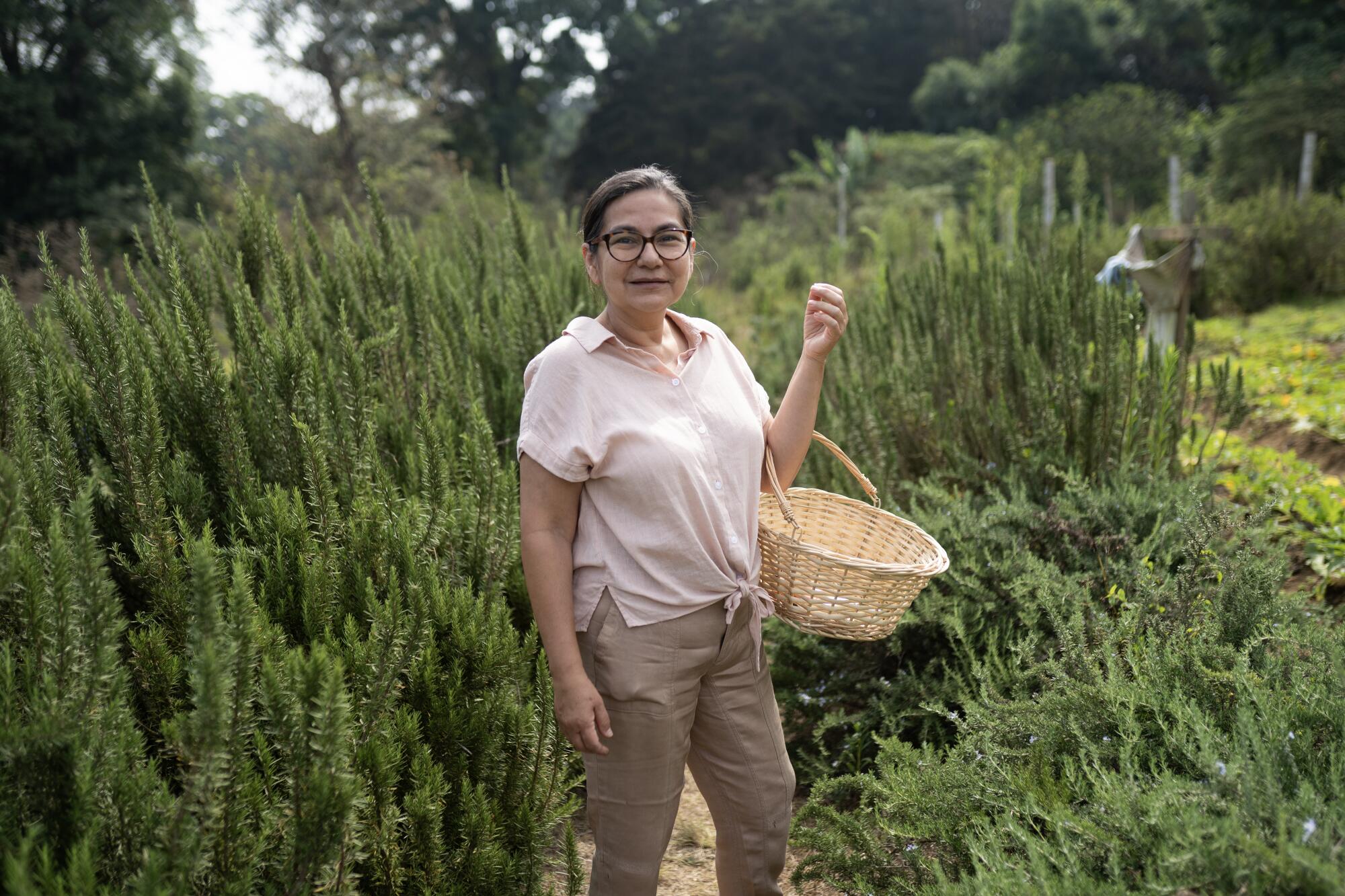
Ana Virginia Juarez of Tikonel Farms in Santa Lucia Milpas Altas, in an space the place the crops meet the forest.
(James Rodriguez / For The Occasions)
That’s as a result of Perez practices regenerative farming, which tends to look a bit messy however creates the healthiest soil for his natural produce.
Guatemala is blessed with nutrient-rich volcanic soil and distinctive microclimates that create perfect rising situations for 1000’s of herbs, legumes, grains, fruits, greens and fungi — most of them native or endemic to Guatemala or Mesoamerica. However years of typical monoculture agriculture and the consequences of local weather change have broken the soil.
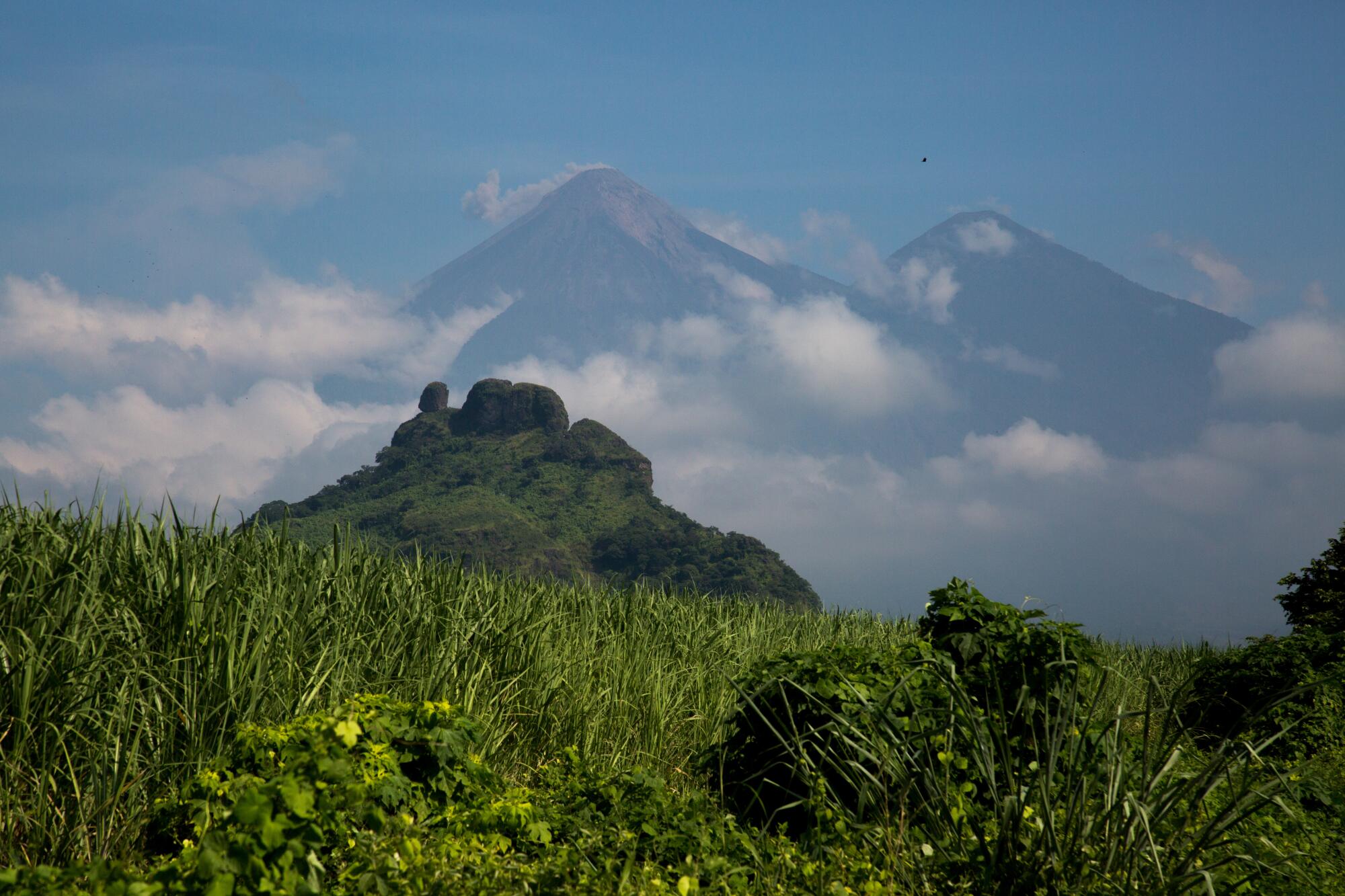
In Escuintla, a view of two of Guatemala’s volcanoes, the energetic Fuego volcano, left, and the non-active Acatenango volcano to its proper.
(James Rodriguez / For The Occasions)
Regenerative farming is vital to Fadul, who says she needs extra producers in her nation would use the identical kinds of methods that transcend sustainable agriculture. Regenerative practices not solely preserve the land however rebuild and enhance the soil in order that it may retailer extra carbon.
Fadul grabs a handful of lately harvested native beans known as piloy, admiring their vibrant hues of purple, cream, pink and even orange. She smells and tastes the herbs and crops sprouting from the darkish soil.
She spots amaranth and caresses the diamond-shaped inexperienced leaves, generally generally known as pigweed in English.
“Have you learnt the story about amaranth?” she asks.

Amaranth planted by natural agriculture educator Erick Torres at his home orchard in San Pedro Las Huertas, Guatemala.
(Johan Ordonez / AFP by way of Getty Photographs)
Wealthy in protein and fiber and sometimes used as a grain, amaranth seeds had been a staple of many Indigenous folks’s diets in Guatemala. When the Spanish arrived, they seen its significance — not just for its dietary worth, which is on par with spinach, however for its use in non secular ceremonies.
Because of this the Spanish, who arrived within the 1500s and got down to management the folks by changing them to Catholicism, banned the cultivation and possession of the crop, which fell into disuse. Additionally they nicknamed the amaranth seed “bledo.”
That is the place the expression “Me importa un bledo” (I don’t give a rattling) originates.
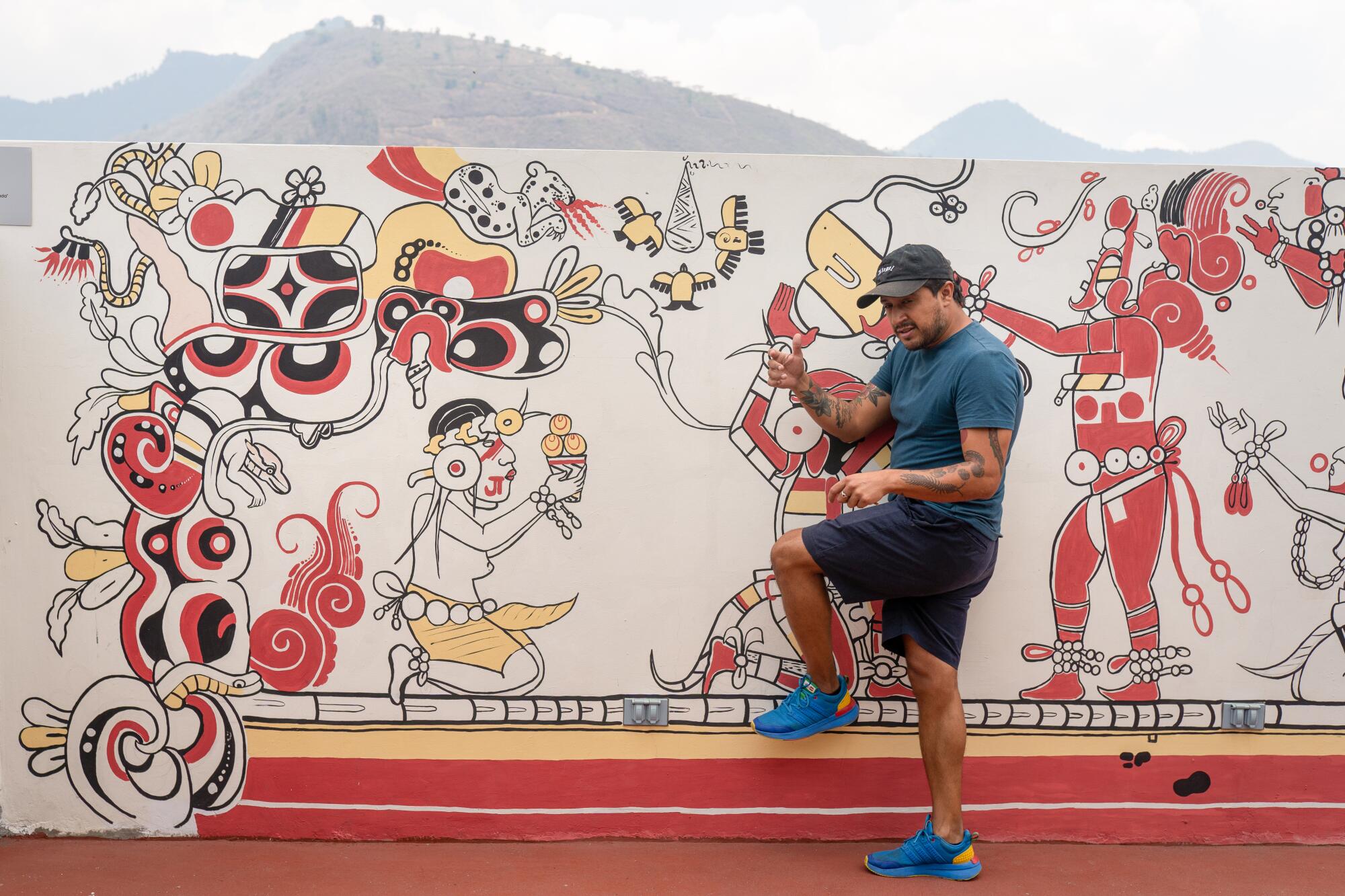
Juan Pablo Romero mimics the motion in a mural at El Patojismo that resembles a Mayan Codex. Romero is the founder and head of El Patojismo, an alternate academic middle for low-income city youth.
(James Rodriguez / For The Occasions)
“The Spanish found that the best solution to conquer us was by way of our meals,” Fadul tells the group. “They made us really feel as if what we had right here didn’t have any worth.”
Centuries after the Spanish invasion, the Indigenous components that remained in Guatemala had been virtually obliterated by waves of immigrants, battle and globalization that introduced new components and cooking practices.
Amaranth confronted near-extinction in Guatemala through the civil warfare that raged within the nation for 36 years till 1996 and left greater than 200,000 useless — the bulk Indigenous Guatemalans. However it wasn’t simply the individuals who bore the brunt of the warfare; it was additionally Indigenous tradition and meals practices.
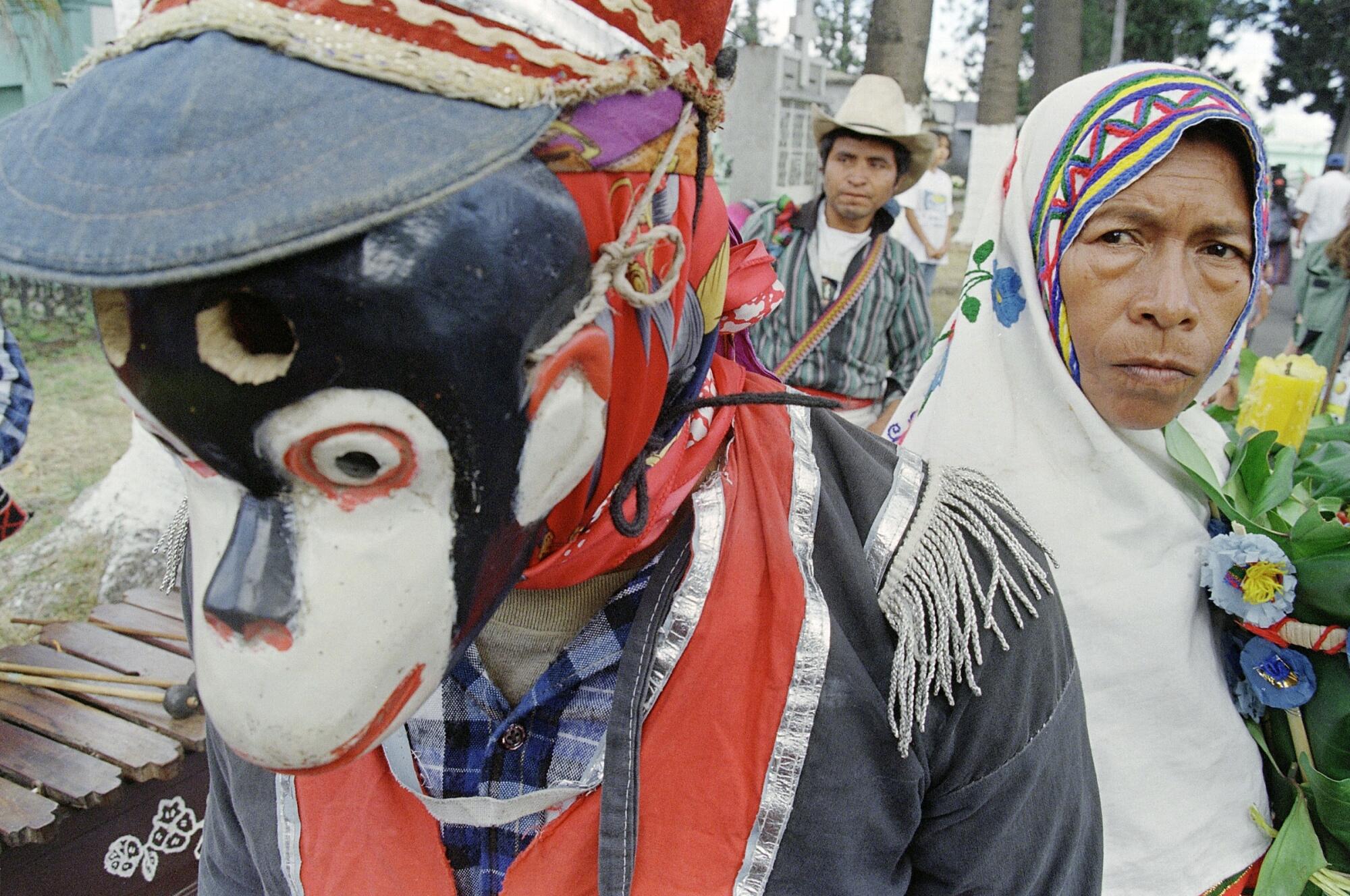
Individuals participate in a ceremony marking the tip of the Guatemalan civil warfare.
(Jorge Uzon / AFP by way of Getty Photographs)
State forces trying to defeat insurgents typically focused Indigenous villages and burned their agricultural fields.
Mass displacement of Indigenous folks through the battle led to a data hole and a disconnect between generations, in keeping with the Meals and Agriculture Group of the United Nations. Recipes usually handed down from mom to daughter had been misplaced and ranges of poverty and malnutrition skyrocketed. Processed meals changed domestically grown produce, such because the beans grown by Matea Gonzalez, a 54-year-old farmer who lives in Parramos, a few 90-minute drive west of Guatemala Metropolis.


Maria Matea Gonzalez, Kakchiquel Mayan bean producer, at dwelling along with her harvest and home made textiles, prime, and holding lately harvested multicolored Piloy beans. (James Rodriguez / For The Occasions)
Fadul greets Gonzalez with a basket of contemporary greens from different producers — beets, radishes, peppers and macuy, a wild herb native to Guatemala that’s thought-about a superfood.
Gonzalez escorts Fadul right into a newly constructed room. It’s sparse apart from almost a dozen straw and plastic baskets on the ground, every crammed with heirloom beans or corn kernels.
“Doña Matea, your beans are simply lovely,” Fadul tells her. “They’re spectacular.”
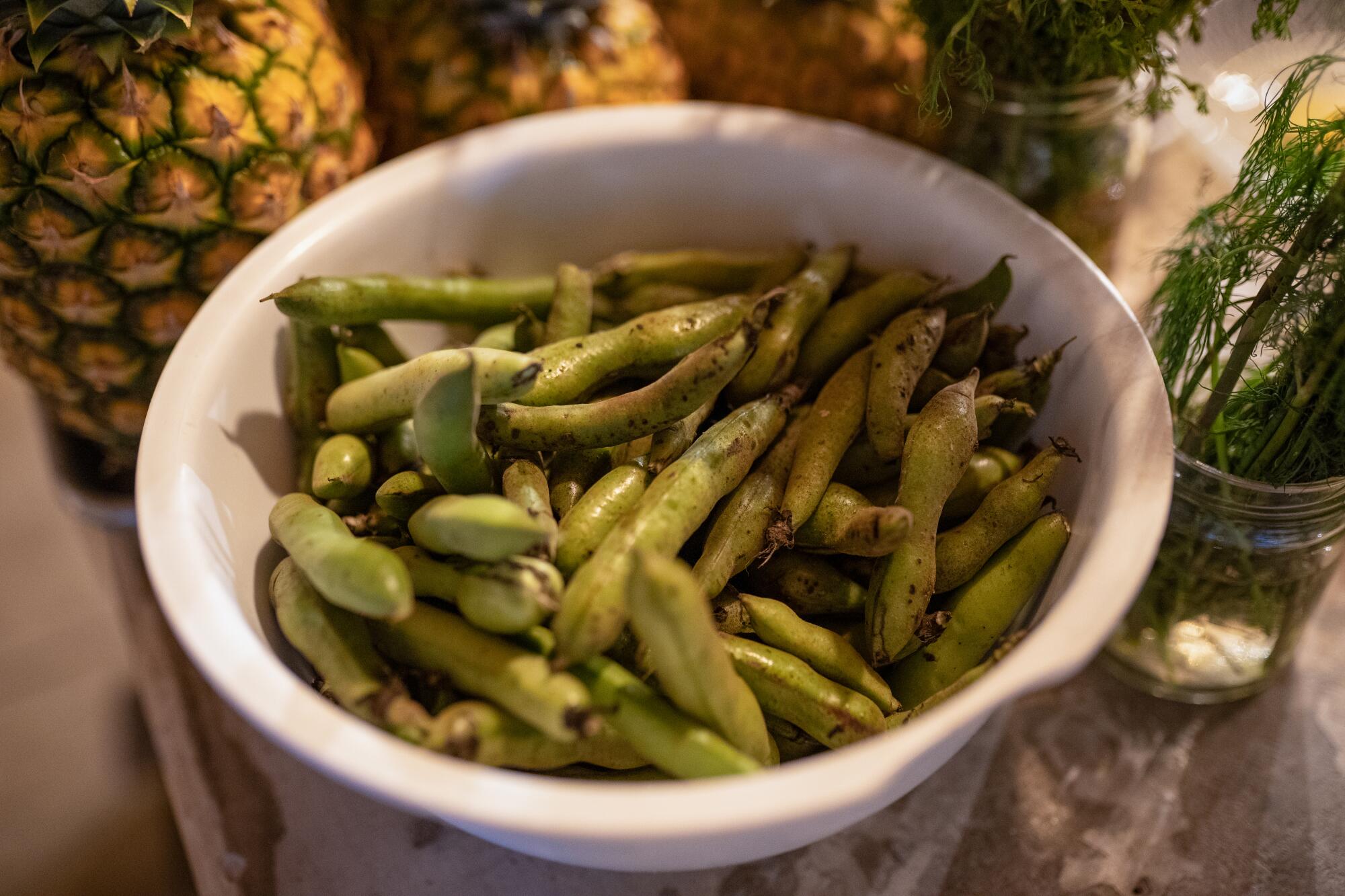
Bean pods in a bowl at Diaca Restaurant.
(James Rodriguez / For The Occasions)
She runs her fingers although a basketful of small white beans known as “perla del suelo” — pearl of the bottom — adorned with vein-like strains. It’s an heirloom bean native to Guatemala.
“These are my favorites,” Fadul says along with her infectious smile.
Gonzalez, a religious Catholic who wears conventional Indigenous garb and speaks the Mayan language of Kaqchikel, locations a few of her greatest produce in smaller baskets on prime of an altar she erected to thank God for the harvest.
“I actually do admire your help,” she tells Fadul in Spanish. “You give me a good worth.”
Gonzalez usually sells her beans to an middleman who can pay about 5 quetzales — roughly 64 U.S. cents — per pound. After she components in the fee and labor of manufacturing the beans, she makes solely about 2 quetzales — about 25 cents — in revenue per pound.
In Guatemala Metropolis, you’ll discover the identical bean for 45 quetzales — almost $6 — a pound at a grocery retailer.
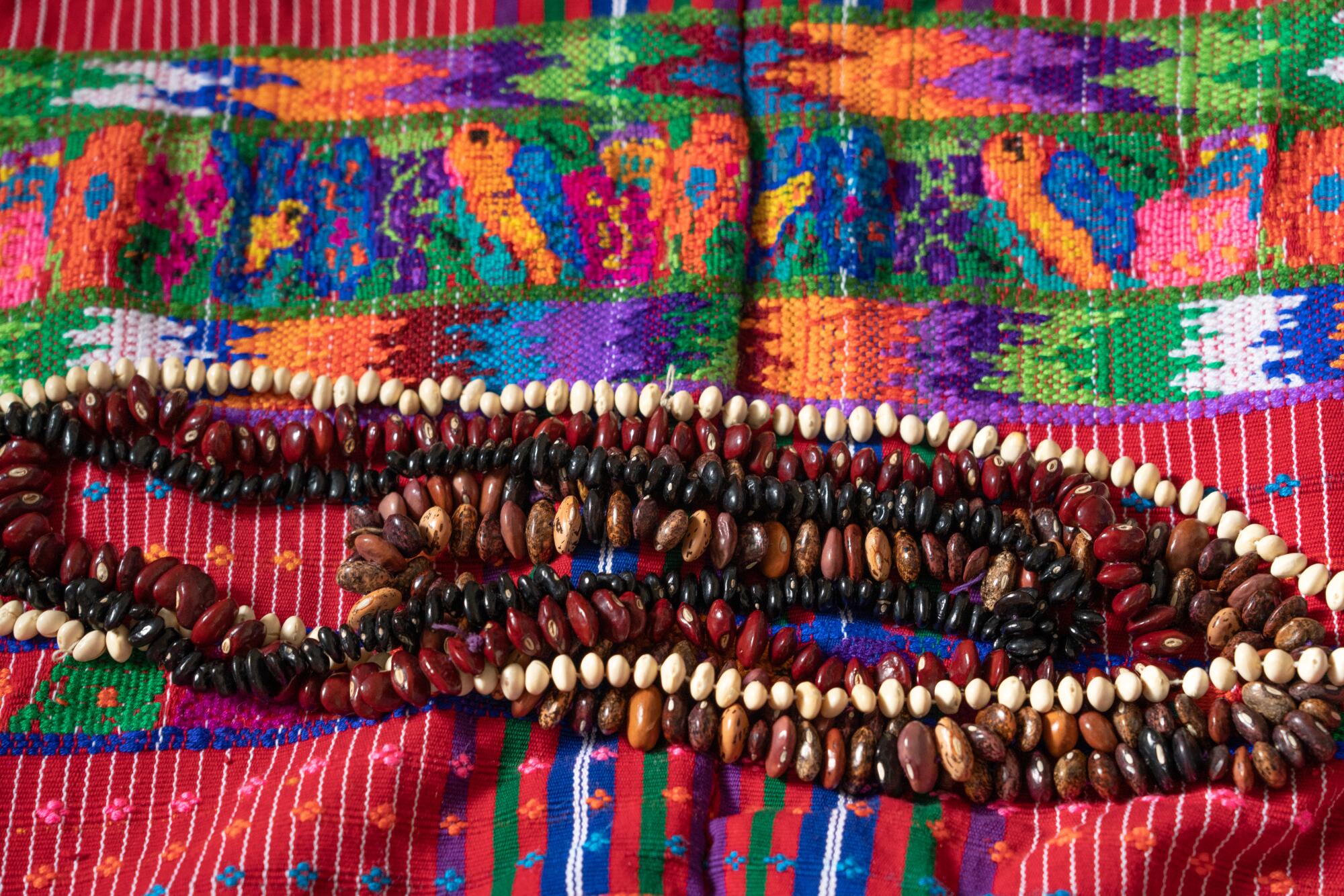
Necklaces constituted of beans on a home made guipil, or conventional Guatemalan shirt, on the dwelling of Maria Matea Gonzalez.
(James Rodriguez / For The Occasions)
“That is the truth of all of the producers,” Fadul says, “from those that develop flowers to espresso and corn. All producers.”
It’s one of many causes Fadul pays double the intermediary’s worth for Gonzalez’s beans.
Her aim is to make farmers like Gonzalez pleased with what they produce and provides worth to what they develop — to provide them a voice of their nation.
Simply as vital is getting diners and residential cooks to understand what their nation can produce. The common Guatemalan has forgotten or by no means knew about many native components akin to Gonzalez’s heirloom beans .
Because of this Fadul teaches cooking lessons at El Patojismo, an alternate academic middle for low-income city youth. She additionally created a searchable digital database of Guatemalan producers known as Crece en Guate (Grown in Guatemala). The web site offers producers visibility and supplies a manner for customers to make contact and purchase straight from the farmers.
At her personal restaurant, she and her crew work with farmers, archaeologists and biologists to discover the biodiversity of Guatemala. She sources from greater than 45 meals producers and showcases the components in a hard and fast menu at Diacá.
Fadul says she by no means tells a farmer or rancher what she wants.
As a substitute, she asks: “What do you’ve gotten?”
And with that, she builds a menu.
Within the restaurant
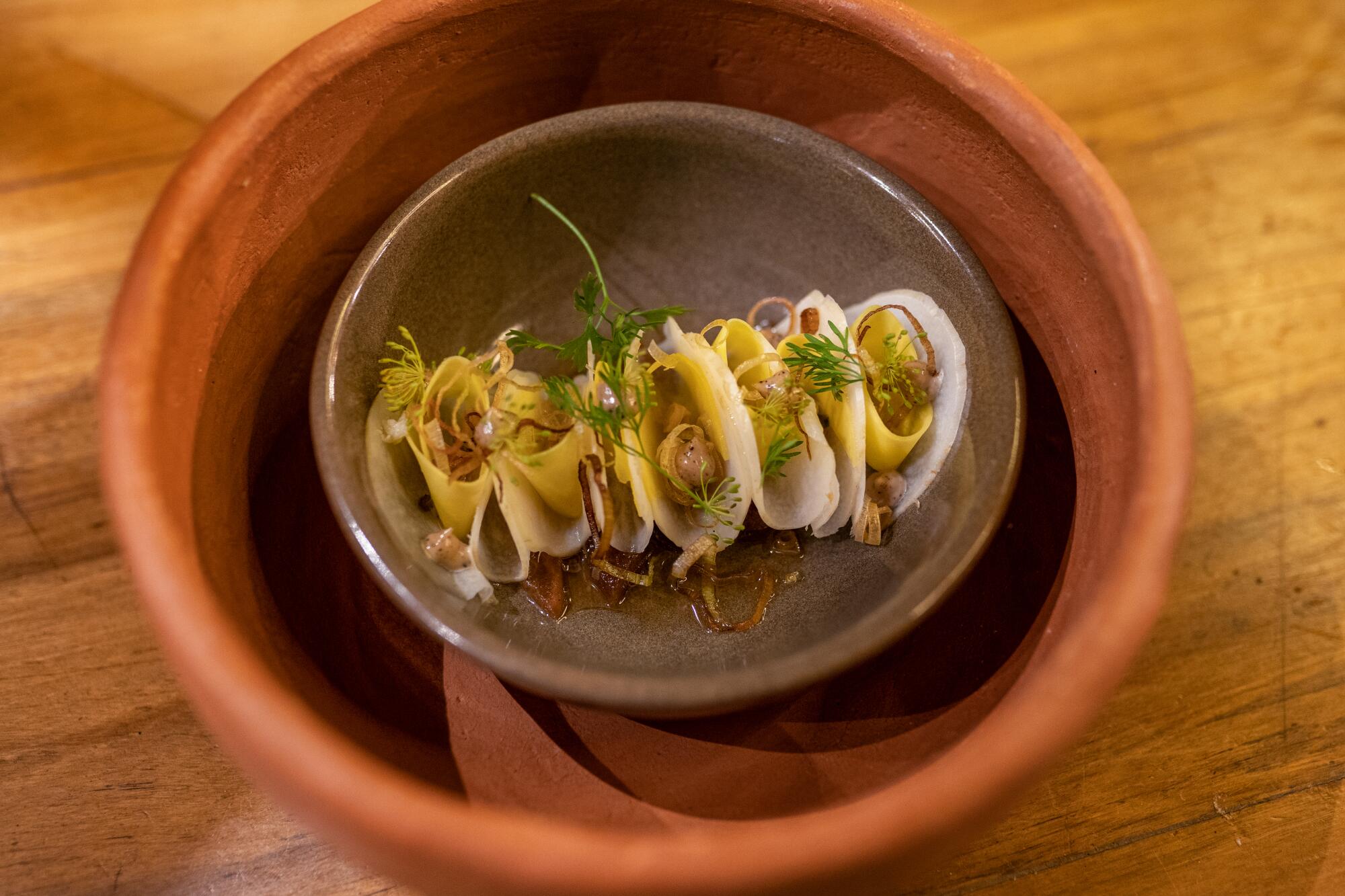
At Diacá, pink snapper with mango and perulero.
(James Rodriguez / For The Occasions)
Born and raised in a middle-class household in Guatemala, Fadul by no means considered leaving Guatemala for culinary coaching overseas.
After graduating from Camille Escuela de Alta Cocina in Guatemala Metropolis, she launched a catering firm known as Chef de Mon Coeur in 2008. That enterprise allowed her to discover numerous components within the nation and helped her promote Guatemalan gastronomy. She additionally had a seasonal pop-up idea the place she put collectively gastronomic experiences across the metropolis and the countryside.
In 2018, she opened Diacá. The title, a sly misspelling of “de acá,” which suggests “from right here” in Spanish, displays Fadul’s playful and purposeful mission.
Perched on the rooftop terrace of a midcentury constructing within the hip neighborhood of Cuatro Grados Norte, Diacá has turn out to be one thing of a refuge from the hustle and bustle of Guatemala Metropolis. Most diners share a single desk encircled by clear glass partitions. It’s a small house that may seat solely about two dozen diners at a time.
The restaurant’s vibe is the alternative of formal. Most if not the entire workers of about 10 are youthful than 40. The company look like well-heeled and might afford the 450 quetzales — about $55 — for the eight-course tasting menu, which varies relying on the season and what producers have out there.
New diners don’t fairly know what to anticipate earlier than they step foot in the restaurant however are put comfy when welcomed by a pleasant member of the crew. Consuming here’s a generally emotional expertise for locals, who might style an ingredient their mom or grandmother as soon as used to create a beloved dish. Solely now it’s ready a bit in another way.

Cooking college students Yustina Quina, left, Paulino Alquijay and Andy Alquijay peel güisquil on the cafeteria in El Patojismo, an alternate academic middle for low-income city youth.
(James Rodriguez / For The Occasions)
As an illustration, the inexperienced, pear-shaped squash known as güisquil — also called chayote — is native to Mesoamerica and generally boiled and utilized in soups or stews. However on one spring night, Fadul and her crew served skinny slices of the uncooked fruit, which tastes like a cross between jicama and cucumber.
One Guatemalan diner was overwhelmed when she took a chunk.
“I do know this taste,” she says. She couldn’t fairly place it.
“It’s güisquil,” says Manuel Montepeque, 26-year-old head bartender and program director on the restaurant.
Her eyes roll again into her head and he or she grins with glee.
“I’ve by no means had güisquil like this earlier than,” she says.
After giving a prolonged rationalization of the most recent course — the components, the areas and producers — Montepeque returns to his cocktail making. Moments later, he‘s serving to within the kitchen — an open room behind an island the place you may clearly see every thing. Principally everybody has a job or specialty, however everybody trains to perform a little little bit of every thing.
“That’s the best way it’s right here,” Fadul explains. “Everybody right here washes dishes, together with myself.”

Diacá bar supervisor and program director Manuel Montepeque prepares drinks with native Guatemalan fruits, together with jocote and mamey.
(James Rodriguez / For The Occasions/James Rodriguez/Los Angeles Occasions)
Fadul doesn’t run her kitchen within the classical French manner. She doesn’t care a lot for the ingrained hierarchy and seriousness of it. The principle goal is to respect the components and the folks you’re employed with.
“There must be love and happiness within the meals you make,” she says. “When you don’t have that, the patron will discover it. You switch that vitality with what you make.”
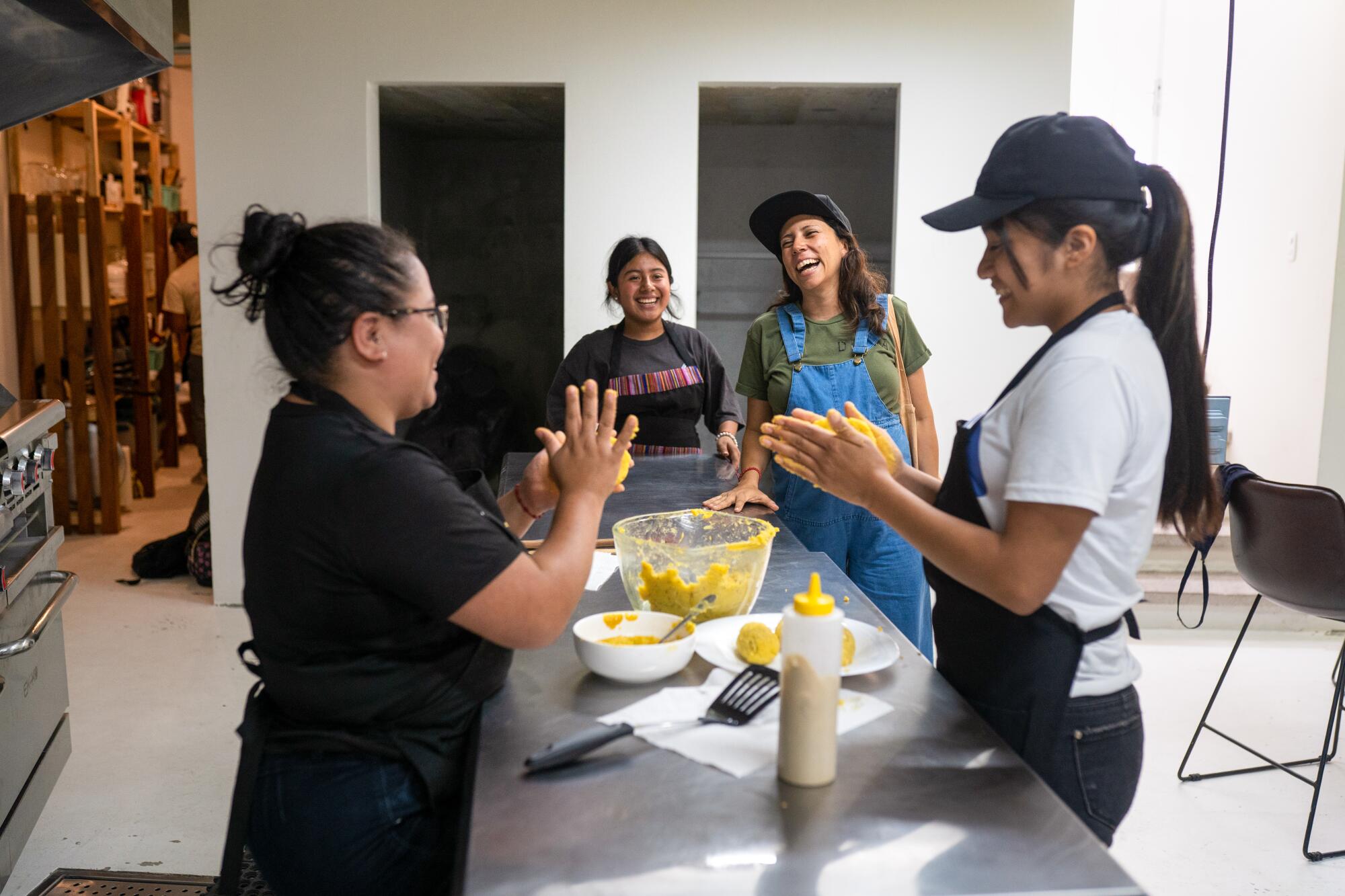
Chef Debora Fadul, in overalls, laughs with workers and college students on the cafeteria in El Patojismo, an alternate academic middle for low-income city youth.
(James Rodriguez / For The Occasions)
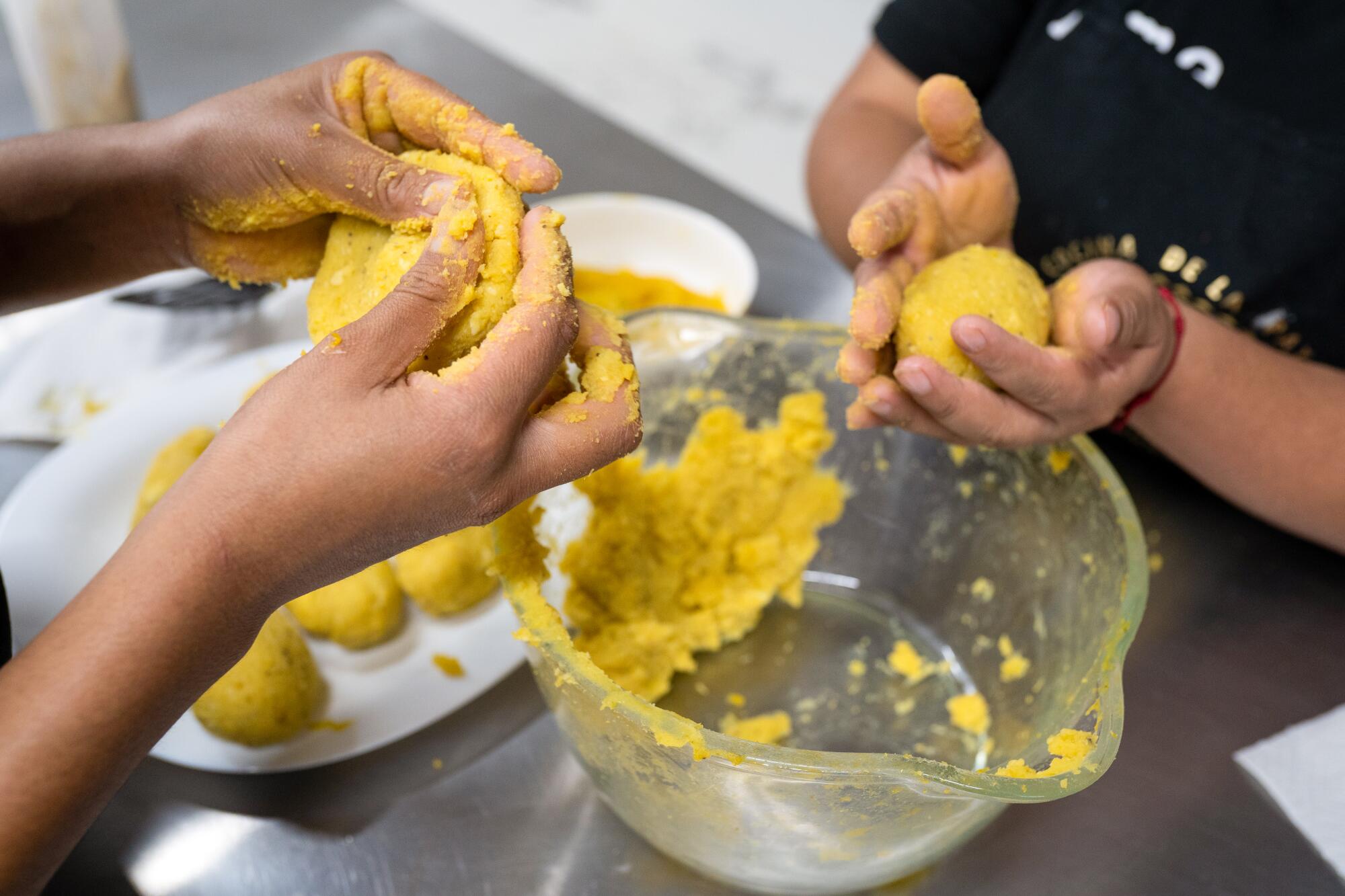
Kitchen workers on the cafeteria in El Patojismo make an alternate model of rellenitos, a standard Guatemalan snack constituted of smashed plantains and crammed with candy bean paste. On this model, the rellenitos are crammed with candy cornmeal and dressed with a pumpkin seed sauce.
(James Rodriguez / For The Occasions)
Fadul and her teammates snort and share tales as they cook dinner. On that night, Fadul styled her hair again with a shawl — certainly one of many who belonged to her grandmother, who was a cook dinner and impressed her to do the identical.
A number of the diners appear starstruck once they meet her, commending her on what they’ve simply eaten. She stresses that her crew and the producers deserve the popularity. That mantra is one thing the crew takes significantly.
“Right here, the star isn’t the chef,” Montepeque tells a pair who showers Fadul with reward. “The celebs listed below are the producers, the components and the place they arrive from.”




